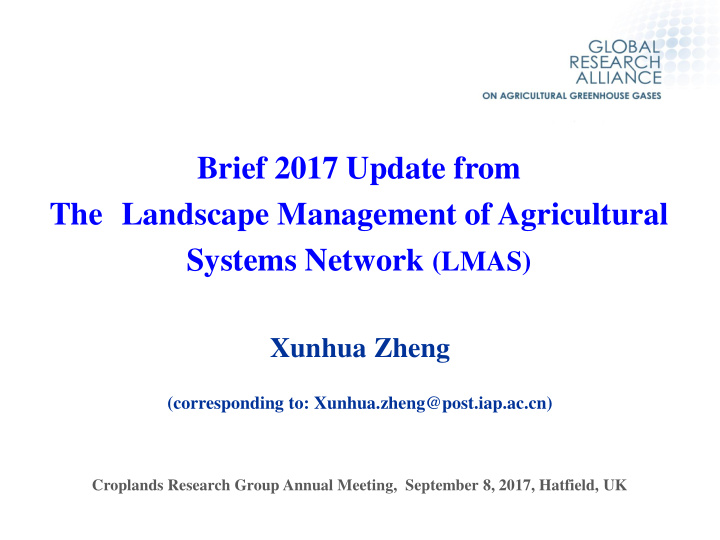



Brief 2017 Update from The Landscape Management of Agricultural Systems Network (LMAS) Xunhua Zheng (corresponding to: Xunhua.zheng@post.iap.ac.cn) Croplands Research Group Annual Meeting, September 8, 2017, Hatfield, UK
The LMAS Aims and Activities The Network Aims To develop process-oriented carbon and nitrogen biogeochemical model(s), and to validate them at ecosystem, landscape and/or catchment scales. To design and promote application of process model-based tool(s) to enable virtual science experiments and/or management decision support for reducing greenhouse gas emissions at the landscape level. The Network Activities Improve and validate model(s) at the aforementioned scales. Create a demonstration tool of virtual experiment or management decision support for a catchment scale. Develop project proposal(s) for cooperative researches aiming at the network goals. Align future activities with the Integrative Research Group. CRG Annual Meeting, September 8, 2017, Hatfield, UK
GHGfom -- a LMAS research Project GHGfom: Effects of climate and management practices on yield and GHG footprint of maize cultivation Five-year NSFC-UNEP joint project: Jan. 2018 to Dec. 2022 Participants: X. Zheng 1 , N. Raut 2 , K. Butterbach-Bahl 3 , R. Sommer 4 Z. Yao 1 , S. Han 1 , W. Zhang 1 , S. Li 1 , C. Fu 5 Institutions: 1 Institute of Atmospheric Physics, CAS, China 2 International Ecosystem Management Partnership, UNEP 3 International Livestock Research Institute (ILRI)/CGIAR, Kenya 4 International Center of Tropic Agriculture (CIAT)/CGIAR, Kenya 5 Institute of Geographic Sciences and Natural Resource Research, CAS, China Target agricultural systems: maize cultivation in tropic (Kenya) and warm temperate/cool temperate (China) climates Models to be involved: LandscapeDNDC, CropSys, CNMM-DNDC CRG Annual Meeting, September 8, 2017, Hatfield, UK
GHGfom aims at tool development for decision support of climate-smart maize production I = GHG n / CP GHG footprint (I): a key index for assessment of the GHG mitigation Crop Net GHG flux over the production entire life cycle A fiscal tool using GHG footprint in to mitigate climate change ( De Camillis & Goralczyk, 2013 ) : A green Value Added Tax in the k th year GHG footprint in the (k-1) th year VAT k = VAT – ( I k-1 – I k ) / I k-1 GHG footprint in the k th year The Value Added Tax regardless of GHG footprint CRG Annual Meeting, September 8, 2017, Hatfield, UK
GHGfom aims at tool development for decision support of climate-smart maize production Climate-smart maize production High maize yield Low new N r input Low GHG footprint CRG Annual Meeting, September 8, 2017, Hatfield, UK
GHGfom aims at tool development for decision support of climate-smart maize production N 2 O CH 4 N 2 O CH 4 CO 2 ( On-farm ) ( Direct ) ( Indirect ) ( On-farm ) (On-farm) CO 2 , CH 4 , N 2 O CO 2 , CH 4 , N 2 O ( Off-farm ) ( On-farm ) SOC ( Change rate of soil C stock ) Irrigation Fertilization Harvest Sowing Plough Pesticide spray GHG n = ( C E – SOC) + ( M E - M U ) GWP m + N E GWP n GHG n , net life-cycle GHG emission (CO 2 eq); C, CO 2 ; N: N 2 O; M, CH 4 ; E, emission; U, uptake ; SOC , change rate of soil C stock CRG Annual Meeting, September 8, 2017, Hatfield, UK (ISO 14040 2006)
GHGfom aims at tool development for decision support of climate-smart maize production Climatic zone: tropical, warm temperate and the transition of the typical and the cool temperate; Management practice: fertilization, tillage, cropping system, crop residue and other field operations; Direct measurement of the yield, CH 4 and N 2 O fluxes and/or SOC: climate and management effects CRG Annual Meeting, September 8, 2017, Hatfield, UK
GHGfom aims at tool development for decision support of climate-smart maize production CropSys LandscapeDNDC CRG Annual Meeting, September 8, 2017, Hatfield, UK
GHGfom aims at tool development for decision support of climate-smart maize production CRG Annual Meeting, September 8, 2017, Hatfield, UK
Questions GHGfom will attempt to answer in terms of maize cultivation How to accurately quantify GHG footprints? How can extreme climate events impact GHG footprint? How to maximize yields while minimizing the GHG footprints? Is it possible to solve the problems of N r -deficit in Africa and N r -surplus in China through cooperation in maize cultivation? CRG Annual Meeting, September 8, 2017, Hatfield, UK
Thanks for your attention ! Xunhua Zheng from LAPC, Institute of Atmospheric Physics, Chinese Academy of Sciences, Beijing 100029, China
Recommend
More recommend